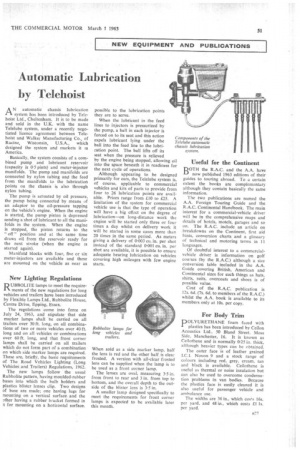Automatic Lubrication by Telehoist
Page 53

If you've noticed an error in this article please click here to report it so we can fix it.
AN automatic chassis lubrication system has been introduced by Telehoist Ltd., Cheltenham. It is to be made and sold in the U.K. with the name Telelube system, under a recently negotiated licence agreement between Telehoist and Walker Manufacturing Co., of Racine, Wisconsin, U.S.A., which designed the system and markets it m America.
Basically, the system consists of a combined pump, and lubricant reservoir (capacity is 0-5 pints) and meter-injector manifolds. The pump and manifolds are connected by nylon tubing and the feed from the manifolds to the lubrication points on the chassis is also through nylon tubing.
The pump is actuated by oil pressure, the pump being connected by means of an adaptor to the oil-pressure tapping on the vehicle's engine. When the engine is started, the pump piston is depressed sending a shot of lubricant to all the manifolds in the system. When the engine is stopped, the piston returns to the " off " position and at the same time draws oil from the reservoir ready for the next stroke (when the engine is started again).
Manifold blocks with four, five or six meter-injectors are available and these are mounted on the vehicle as near as possible to the lubrication points they are to serve.
When the lubricant in the feed lines to injectors is pressurized by the pump, a ball in each injector is forced on to its seat and this action expels lubricant lying under the ball into the feed line to the lubrication point. The ball lifts off its seat when the pressure is relieved by the engine being stopped, allowing oil into the space beneath it in readiness for the next cycle of operations.
Although appearing to be designed primarily for cars, the Telelube system is, of course, applicable to commercial vehicles and kits of parts to provide from four to 26 lubrication points are available. Prices range from £10 to £25. A limitation of the system for commercial vehicle use is that the type of operation will have a big effect on the degree of lubrication—on long-distance work the engine will be started only three or four times a day whilst on delivery work it will be started in some cases more than 20 times in the same period. As meters giving a delivery of 0.003 cu. in. per shot instead of the standard 0.001 cu. in. per shot are available, it is possible to ensure adequate bearing lubrication on vehicles covering high mileages with few engine starts.
















































































































































